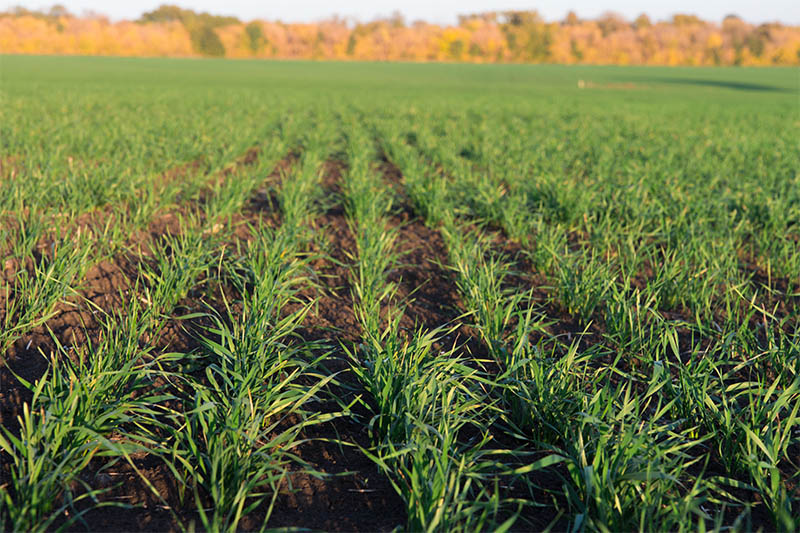There are a variety of factors that must be taken into account in order to successfully seed for winter wheat.
Certain things need to be done correctly to have a good crop and these items all have equal importance. This article will take a look at what you need to insure a successful winter wheat crop.
First of all, seed early. The most important thing you can do to increase the chances of your crop surviving the winter is to plant early. As a grower, it is crucial to recognize that plants entering the winter with more than three leaves generally have well developed crowns. The crown is, of course, the base from which the plant will grow in the spring-time.
While seeding early is important, at the same time you don’t want to seed too early as that can lead to excess growth prior to winter which increases the risk of winter injury to the crop. Also the larger the plant, the greater the risk of snow mold.
The best time for seeding for winter wheat is generally a window between September 1st and the 15th.
If you intend to use the crop for fall grazing, that date should be moved forward to around the middle of August. Many factors need to be taken into account as to how early to seed your winter wheat. Your region also has a lot to do with it and you may want to consult an agronomist in your area to make sure what time is the right time for you.
The next thing you want to always do when it comes to seeding winter wheat is to seed heavy. Seed size obviously will vary among the different varieties of wheat and because of this variation the number of plants to a bushel is also highly variable. You can use this formula to calculate seeding rate according to the variety that you are planting:
- Seeding rate (lb/ac)=target plant population/ft2 X 1000 kernel wt. (g)/seedling survival rate (0.70) / 10.
- TKW in grams is used because the average number of seeds per pound varies.
- Calculate a seedling survival rate of 0.70 to take into account germination and emergence rate (this is similar to spring crops as well) plus the impact of winter survival. This is necessary because some plants inevitably do not survive harsh winter conditions.
The third thing you will want to do when seeding your winter wheat crop is to make sure that you seed shallow. The moisture in most stubble fields has usually been depleted, which leaves a dry seedbed for winter wheat. Because of this, seeding ½” to 1” in depth allows the seeds to take advantage of rainfall.
As little as 1/3” inch of rain can allow shallowly seeded winter wheat to successfully establish itself. On the other hand, deep seeding will delay emergence which can result in a rather thin, spindly plant that is much more susceptible to winter kill. It is a proven fact that shallow seeding is more successful than deep seeding when it comes to winter wheat. You should also make sure the seed is well packed into the soil to insure seed to soil contact. This will help lock in any moisture for fall germination.
Fourthly, always remember to seed slowly. Winter wheat will perform better if it is seeded at speeds in the 4 mph to 6 mph range. Going any faster than that while seeding will often result in non-optimal crops.
Lastly, using a seed treatment is always a good idea when it comes to planting winter wheat. If you are at a high risk for seedling disease development, a seed treatment becomes even more of a necessity. Research has shown that the use of a fungicide/insecticide seed treatment greatly increases the chances of seed survival. Many times it is tempting not to utilize a seed treatment, but overall it should be considered to make sure that your crop turns out as healthy as possible.
Direct seeding into standing stubble is also important for winter wheat. Standing stubble will serve to trap snow, which in turn will insulate the crown from the cold weather during the winter. Snow cover will insure that the soil around the crown stays above killer temperatures even down as far as -40 degrees Celsius. Four inches of snow is optimal for the stubble to hold to prevent soil temperatures from dropping too much. This will also improve moisture reserves for the spring.
Stubble such as canola, barley, oat, flax, or the stubble of a forage crop all consistently yield the type of tall, dense stubble that is optimal for trapping snow. Wheat stubble is also dense, but is not generally recommended due to the potential risk for wheat streak mosaic virus.
Crops that do not provide tall, dense, stubble such as field pea and lentil are not recommended even though they are sometimes commonly used. Using these crops for stubble will greatly increase the risk of winterkill.
Overall, all of these factors together should be taken into account when seeding winter wheat. Many people factor in one or two items, but in order to insure the greatest chance of success for your winter wheat crop, it is necessary to follow these steps as much as possible.
Admittedly, things can still go amiss if certain conditions are not met, but following these will give your crop not only the greatest chance of survival, but also the best chance of yielding a healthy, productive crop of winter wheat.
Have questions about winter wheat? Give our Agronomy team a call or learn more on our website.



